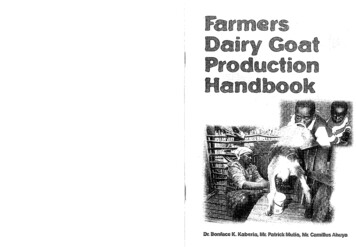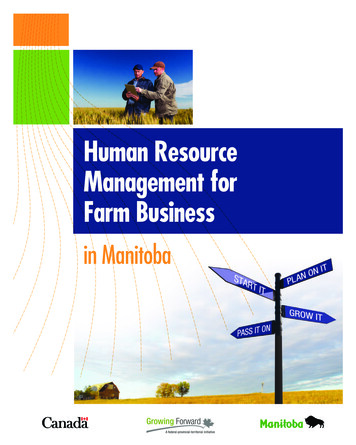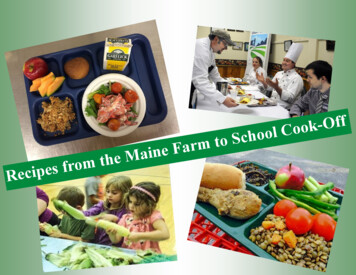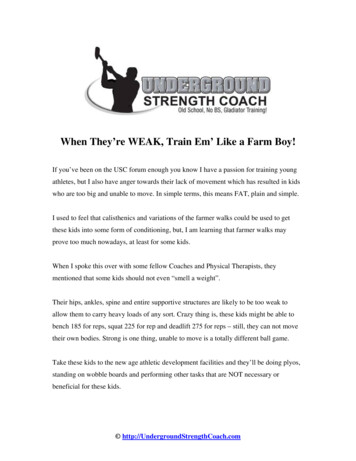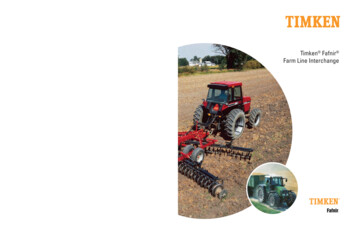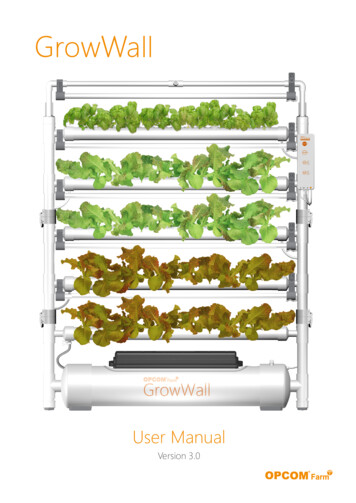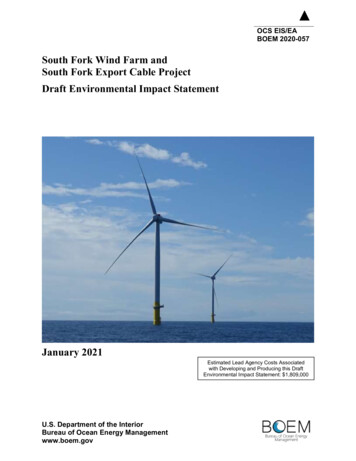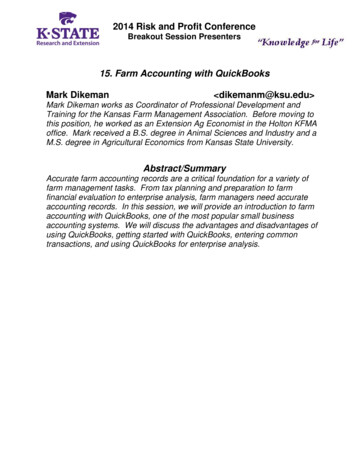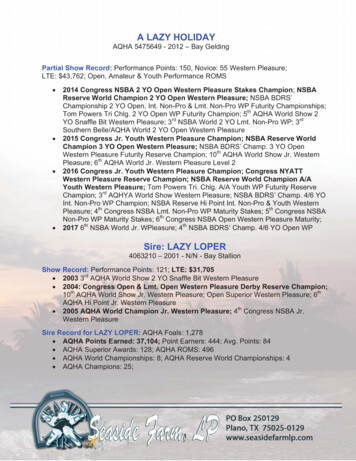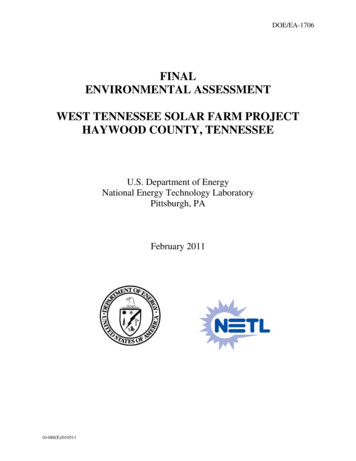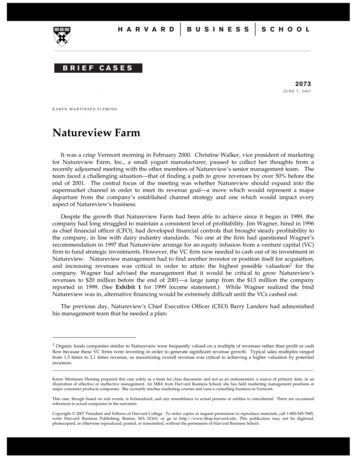
Transcription
For the exclusive use of Y. Al Jaafary, 2017.2073JUNE 7, 2007KAREN MARTINSEN FLEMINGNatureview FarmIt was a crisp Vermont morning in February 2000. Christine Walker, vice president of marketingfor Natureview Farm, Inc., a small yogurt manufacturer, paused to collect her thoughts from arecently adjourned meeting with the other members of Natureview’s senior management team. Theteam faced a challenging situation—that of finding a path to grow revenues by over 50% before theend of 2001. The central focus of the meeting was whether Natureview should expand into thesupermarket channel in order to meet its revenue goal—a move which would represent a majordeparture from the company’s established channel strategy and one which would impact everyaspect of Natureview’s business.Despite the growth that Natureview Farm had been able to achieve since it began in 1989, thecompany had long struggled to maintain a consistent level of profitability. Jim Wagner, hired in 1996as chief financial officer (CFO), had developed financial controls that brought steady profitability tothe company, in line with dairy industry standards. No one at the firm had questioned Wagner’srecommendation in 1997 that Natureview arrange for an equity infusion from a venture capital (VC)firm to fund strategic investments. However, the VC firm now needed to cash out of its investment inNatureview. Natureview management had to find another investor or position itself for acquisition,and increasing revenues was critical in order to attain the highest possible valuation1 for thecompany. Wagner had advised the management that it would be critical to grow Natureview’srevenues to 20 million before the end of 2001—a large jump from the 13 million the companyreported in 1999. (See Exhibit 1 for 1999 income statement.) While Wagner realized the bindNatureview was in, alternative financing would be extremely difficult until the VCs cashed out.The previous day, Natureview’s Chief Executive Officer (CEO) Barry Landers had admonishedhis management team that he needed a plan:1 Organic foods companies similar to Natureview were frequently valued on a multiple of revenues rather than profit or cashflow because these VC firms were investing in order to generate significant revenue growth. Typical sales multiples rangedfrom 1.5 times to 2.1 times revenue, so maximizing overall revenue was critical to achieving a higher valuation by potentialinvestors.Karen Martinsen Fleming prepared this case solely as a basis for class discussion and not as an endorsement, a source of primary data, or anillustration of effective or ineffective management. An MBA from Harvard Business School, she has held marketing management positions atmajor consumer products companies. She currently teaches marketing courses and runs a consulting business in Vermont.This case, though based on real events, is fictionalized, and any resemblance to actual persons or entities is coincidental. There are occasionalreferences to actual companies in the narration.Copyright 2007 President and Fellows of Harvard College. To order copies or request permission to reproduce materials, call 1-800-545-7685,write Harvard Business Publishing, Boston, MA 02163, or go to http://www.hbsp.harvard.edu. This publication may not be digitized,photocopied, or otherwise reproduced, posted, or transmitted, without the permission of Harvard Business School.This document is authorized for use only by Yousif Al Jaafary in Applied Marketing Management 2-1-1-1-1-1-1-1 taught by Devon Johnson, Montclair State University from October 2017 toDecember 2017.
For the exclusive use of Y. Al Jaafary, 2017.2073 Natureview FarmWe have to come up with a plan that takes us to 20 million in revenues by the end of 2001.This immediate pressure to grow the top line is going to help us get to the size that we havelong aspired to be. As you think through our options, though, you can’t lose sight of what hasmade this company great. I’m proud of the strong brand we’ve built and what it represents inour marketplace, and I’m even more proud of the unconventional route we’ve taken to gethere. We owe it to our customers, our suppliers, and our distribution partners to make theright strategic choices regarding the revenue growth objective before us.Those words weighed heavily on the Natureview management team. The first meeting to addressthe CEO’s challenge had not gone well. After much analysis and discussion, the team members weresharply divided.Natureview Farm’s Early Years and the Current SituationFounded in 1989, Natureview Farm manufactured and marketed refrigerated cup yogurt underthe Natureview Farm brand name. The yogurt was manufactured at the Natureview Farmproduction facility in Cabot, Vermont. The key to the Natureview yogurt flavor and texture was thefamily yogurt recipe developed by the company’s founder. The recipe used natural ingredients and aspecial process that gave the yogurt its unique smooth, creamy texture without the artificialthickeners used by the major U.S. yogurt brands—Dannon, Yoplait, and Breyers. The company usedmilk from cows untreated with rGBH, an artificial growth hormone that increased milk production.Because of the special process and ingredients, Natureview Farm’s yogurt’s average shelf life (thelength of time the yogurt stayed fresh) was 50 days. Most of the large competitors’ products had a 30day shelf life, requiring them to build multiple production plants to reduce shipping time to theirdistributors.In 10 years, Natureview Farm’s revenues had grown from less than 100,000 to 13 million. Thecompany first entered the market with 8-ounce (oz.) and 32-oz. cup sizes of yogurt in two flavors—plain and vanilla. Based on its early success, the company added flavors to both sizes. The 8-oz.flavors were developed by putting fruit puree into the bottom of the cup and adding plain yogurt ontop. Producing this “fruit on the bottom” yogurt product required new equipment, but it allowed thebrand to expand its product offerings to help increase revenues. Because of the emphasis on naturalingredients and its strong reputation for high quality and great taste, the Natureview brand grewquickly to national distribution and shared leadership in the natural foods channel. This was aidedby creative, low-cost “guerilla marketing” tactics that worked well in this channel.By 2000, Natureview Farm produced twelve refrigerated yogurt flavors in 8-oz. cups (86%revenues) and four flavors in 32-oz. cups (14% revenues). The company had also started exploringmultipack yogurt products (children’s 4-oz. cups and yogurt packaged in tubes). Natureviewshipped its yogurt to retailers in cases, with a typical case containing 12 cups for the 8-oz. and 6 cupsfor the 32-oz. product lines, respectively. (If the company were to expand into multipack products,their cases would contain four packages.) As a major brand in the natural foods channel, NatureviewFarm had developed strong relationships with leading natural foods retailers, including the chainsWhole Foods ( 1.57 billion revenues in 1999) and Wild Oats ( 721 million revenues). The organicfoods market, worth 6.5 billion in 1999, was predicted to grow to 13.3 billion in 2003.22 “A Step Closer To Defining ‘Organic,’" Natural Foods Merchandiser 12: 43 (December 1999).2BRIEFCASES HARVARD BUSINESS SCHOOLThis document is authorized for use only by Yousif Al Jaafary in Applied Marketing Management 2-1-1-1-1-1-1-1 taught by Devon Johnson, Montclair State University from October 2017 toDecember 2017.
For the exclusive use of Y. Al Jaafary, 2017.Natureview Farm 2073The Refrigerated Yogurt Category and the Yogurt ConsumerYogurt is a dairy product, the result of milk fermented in a carefully controlled environment.Special bacteria added to the milk change its texture and give yogurt its unique health properties—itis a good source of calcium and improves digestion. Plain yogurt is typically made from whole, lowfat, or nonfat milk without additional flavoring ingredients. Flavored yogurt has sugar and eitherartificial flavorings or natural fruit (or both) added.In 1999, total U.S. retail sales of refrigerated yogurt reached 1.8 billion and sales volume was justover 2.3 billion units. The market was fairly concentrated with the top four competitors—Dannon,Yoplait, Breyers, and Columbo—having the dominant share and the top two competitors controllingover 50% of the market. In 1999, when sales through the dominant two distribution channels—supermarkets and natural foods stores—were combined, supermarkets sold 97% of all yogurtconsumed, and natural food stores sold the balance. Yogurt revenues were also generated throughother channels, including warehouse clubs, convenience stores, drug stores, and mass merchandisers.However, Natureview did not consider entry into these channels because, relative to the supermarketchannel, these channels offered limited revenue generation potential; the company’s product was nota strong fit for the narrow product offering afforded to consumers through these channels; andvolume requirements were prohibitive in certain channels. Warehouse clubs, for example, requiredmultiple unit packages, 24 cups of 8-oz. cups per carton, but Natureview did not view its brand asdeveloped enough to generate the consumer demand necessary to meet this volume requirement. Inthe previous five years, yogurt sales through supermarkets had grown an average of 3% per year,while sales through natural food stores had grown 20% per year. Because consumers wereincreasingly interested in natural and organic foods, well-managed natural foods retailers werethriving. Yogurt was an important product in the overall dairy portfolio of natural foods retailers,since stores earned a higher margin on yogurt than on any other dairy product.Shoppers at natural foods stores tended to be more educated, earn higher incomes, and be olderthan the typical supermarket shopper. Forty-six percent of organic food consumers bought organicproducts at a supermarket, 25% at a small health foods store, and 29% at a natural foodssupermarket. Generally, shoppers who purchased organic products, regardless of channel, tended tohave higher incomes, have more education, and live in the Northeast and West. Organic dairyproducts were bought by 74% of heavy organic food buyers and 29% of light organic food buyers.Sixty-seven percent of U.S. households indicated that price was a barrier to their purchase of organicproducts, and 58% expressed that they would buy more organic product if it were less expensive.Forty-four percent of consumers identified the need for a wider selection of organic product insupermarkets.3Yogurt was consumed by approximately 40% of the U.S. population, with women comprising themajority (over 70%) of yogurt purchases. Factors considered when deciding which yogurt topurchase included package type/size, taste, flavor, price, freshness, ingredients, and whether theproduct was organic, typically in that order of preference. For natural foods shoppers, the product’singredients and whether or not the product was organic were more important purchase criteria.Among natural foods shoppers, a product’s health-promoting qualities were usually more importantthan price in the purchase decision.Regarding consumer product preferences, 6- and 8-oz. yogurt cups were the most popularproduct sizes, representing 74% of total category supermarket sales in U.S. dollars. This segment was3 “A Step Closer To Defining ‘Organic,’" Natural Foods Merchandiser 12: 43 (December 1999); “Organic Products Are On OneThird of Shopping Lists Enhanced Title,” Research Alert 18(7):5 (April 07, 2000); eBrain Market Research,http://www.ebrain.org/ (2002 survey).HARVARD BUSINESS SCHOOL BRIEFCASES3This document is authorized for use only by Yousif Al Jaafary in Applied Marketing Management 2-1-1-1-1-1-1-1 taught by Devon Johnson, Montclair State University from October 2017 toDecember 2017.
For the exclusive use of Y. Al Jaafary, 2017.2073 Natureview Farmgrowing 3% per year, but also faced stiff competition. Women primarily bought 8-oz. yogurt cups asa healthy snack or lunch substitute and valued a variety of flavors since most consumers did not“add” anything to this size. By comparison, the next largest segment—multipacks—represented 9%of category sales and was growing by more than 12.5% per year. Children (and their mothers,seeking healthier snack alternatives) were the target of the fastest growing multipacks. Theseincluded six-packs of 4-oz. cup servings and the “fun and less messy” tube yogurt, which wassqueezed from a flexible plastic tube and could be eaten without a spoon; eight 2-oz. tubes wereincluded in the typical multipack. The last segment, the 32-oz. size, represented 8% of sales and wasgrowing at a modest 2%. Buyers of the 32-oz. size were “heavy“ yogurt consumers, who either atethe yogurt plain, added other ingredients (granola, fruit, etc.), or used yogurt in recipes (smoothies,cooking). For the 32-oz. size, the most popular flavors were plain and vanilla, and the mostimportant purchase criteria were brand, expiration date, and price. (See Exhibit 2 for yogurt marketshare by segment and region in the supermarket channel.)Stores typically merchandised yogurt product in their own section within the refrigerated dairycase. The size of the yogurt section varied from store to store, although on average, the yogurtsection in a natural foods store was smaller (4’ wide by 6’ high) than that in a supermarket (8’ wideby 6’ high). In both channels, the small cups (6-oz. and 8-oz.) were displayed on the upper twoshelves, most commonly at eye level—where consumers more often purchased items, researchshowed. Stores usually put multipacks on the next-lowest shelves and 32-oz. containers in thebottom “well” (the least visible spot).The Sales and Distribution Process:Supermarket Channel vs. Natural Foods StoresSupermarket ChannelLarge consumer products manuf
for Natureview Farm, Inc., a small yogurt manufacturer, paused to collect her thoughts from a recently adjourned meeting with the other members of Natureview’s senior management team. The team faced a challenging situation—that of finding a path to grow revenues by over 50% before the end of 2001. The central focus of the meeting was whether Natureview should expand into the supermarket .

